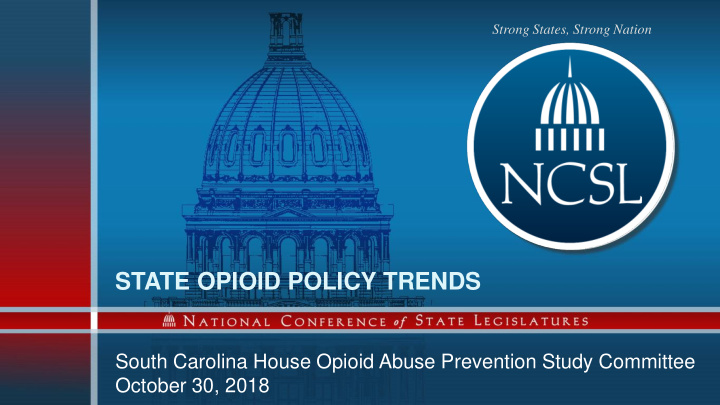



Strong States, Strong Nation STATE OPIOID POLICY TRENDS South Carolina House Opioid Abuse Prevention Study Committee October 30, 2018
Agenda About NCSL The four pillars of opioid health policy State health policy innovations and trends Diversion and deflection from the criminal justice system Treatment for the justice involved
National Conference of State Legislatures Bipartisan, membership organization Each of the 50 states and all territories 7,383 state legislators 30,000+ state legislative staff Research, education, technical assistance Mission: Improve the quality & effectiveness of state legislatures Promote policy innovation and communication among state legislatures Ensure states have a strong, cohesive voice in the federal system
What Does NCSL Do? Research Website: www.ncsl.org Congressional Meetings Invitational Meetings Information Requests State Legislatures Magazine Trainings and Testimony Legislative Summit Social Media
The Four Pillars of Opioid Policy Prevention Intervention Treatment Recovery
Prevention & Intervention
Prevention: State Actions Provider education & training e.g., identifying substance use disorders; pain management; opioid prescribing Voluntary non-opioid directives Drug take-back days/drop-boxes Alternative pain management e.g., acupuncture, massage, chiropractor Prescription drug monitoring programs (PDMPs) Prescription limits or guidelines
Intervention Screening, Brief Intervention and Referral to Treatment (SBIRT) Access to Naloxone Emergency responders, law enforcement, fire fighters Lay persons Third party prescriptions (providing medication to someone other than the at-risk drug user) Good Samaritan overdose/911 immunity
Treatment & Recovery
Treatment: Coverage Medicaid and private payer coverage Funding increases, coverage mandates for detox and inpatient beds Residential treatment is optional for Medicaid-enrolled patients Removing prior authorization, “medically necessary” requirements Strengthening parity Access to Medication-Assisted Treatment (MAT) Requiring equal access and coverage of all FDA-approved MAT i.e., buprenorphine, methadone, and naltrexone
Treatment: Access to Care Increasing the number and type of providers Expanding the number of patients to whom a provider can prescribe buprenorphine Training providers in medication-assisted treatment Expanding the reach of providers through telehealth Expanding providers, settings eligible for reimbursement Specifying substance abuse services
Recovery Peer Support Specialists/Recovery Coaches At least 13 states have a state-wide certification process Centers for Medicare & Medicaid Services require state training and certification for peer support specialists to bill Medicaid Recovery high schools and college campus efforts Other peer networks and support groups Recovery Residences/Sober Living Homes
Strategies and Innovations
Health Tools and Resources NCSL Opioid Policy Deep Dive http://www.ncsl.org/bookstore/state-legislatures- magazine/opioid-deep-dive-state-policy-updates.aspx NCSL Opioid Prescribing Policies Report www.ncsl.org/research/health/prescribing- policies-states-confront-opioid-overdose-epidemic.aspx NCSL Injury Prevention Database www.ncsl.org/research/health/injury-prevention- legislation-database.aspx NCSL Prescription for Pain Management Brief http://www.ncsl.org/documents/health/PainManagement216.pdf NCSL Prescription Drug Monitoring Programs Postcard http://www.ncsl.org/research/health/prescription-drug-monitoring-programs- postcard.aspx Centers for Disease Control and Prevention https://www.cdc.gov/drugoverdose/pdf/pubs/2018-evidence-based-strategies.pdf
Questions?
THE CRIMINAL JUSTICE SYSTEM RESPONSE TO OPIOIDS
EARLY INTERVENTIONS
Deflection Definition: Types of Programs Overdose Response “Stopping a citizen from QRT – Quick Response entering the criminal justice Team system who is at immediate DART – Drug Abuse risk of or is at likely future Response Team PORT – Post Overdose risk of entering the criminal Response Team justice system due to Police Referral behavioral health challenges, and instead LEAD – Law Enforcement deflecting (moving) them Assisted Diversion STEER – Stop, Triage, into the community human Engage, Educate, services system.” Rehabilitate Sources: Jac Charlier, TASC Self-Referral Angel Program
Recent Deflection Enactments California SB 843 (2016) LEAD pilot program and made a $15 million appropriation. Colorado 2017 Budget LEAD pilot program and co-responder programs. Appropriated $5.2 million. Illinois SB 3023 (2018) First enactment authorizing full range of pre-arrest deflection programs. Kentucky SB 120 (2017) Authorized Angel Initiative programs. New Jersey AB 3744 (2016) Authorized law enforcement assisted addiction and recovery program. New Mexico HB 2 (2017) Authorized funding for the study of LEAD in Santa Fe.
Deflection and Diversion Deflection is an emerging legislative trend that reroutes individuals with behavioral health needs before arrest or before contact with the justice system. Statutory pretrial diversion is well established in 48 states and the District of Columbia and reroutes defendants after arrest, but prior to adjudication or final entry of judgment.
Statutory Pretrial Diversion Database Statutory Pretrial Diversion Database
Statutory Pretrial Drug Courts and Diversion Programs States with drug courts States with drug diversion program Updated February 2017 States that have both
CRIMINAL JUSTICE SYSTEM: TREATMENT FOR THE JUSTICE INVOLVED
According to Substance Abuse and Mental Health Services Administration (SAMHSA), the criminal justice system is the single largest source of referral to substance abuse treatment. Sources: SAMHSA Report
States have expanded access to Medication Assisted Treatment (MAT) throughout the criminal justice system MAT has During pretrial release been As part of diversion authorized As part of a probation/parole : In prisons & jails As part of reentry
Recent MAT Diversion Enactments In recent years, at least 12 states have enacted new laws addressing the use of medication assisted treatment in treatment courts and diversion programs. Florida HB 5001 (2016) New York AB 6255 (2015) Illinois HB 5594 (2016) Ohio HB 59 (2013) Indiana SB 464; HB 1304; HB 1448 Tennessee SB 2653 (2016) (2015) Virginia HB 30 (2016) Michigan HB 5294 (2016) Wisconsin AB 657 (2016) Missouri HB 2012 (2016) West Virginia HB 2880 (2015) New Jersey SB 2381 (2015)
Recent MAT Enactments Affecting Incarcerated & Supervised Individuals In recent years, at least 10 states have enacted new laws addressing the use of medication assisted treatment correctional facilities and by supervision agencies. California SB 843 (2016) Missouri HB 10 (2015); HB 10 (2013) Florida HB 5001 (2016) New Jersey SB 2381 (2015) Indiana SB 464; HB 1304; HB Pennsylvania HB 1589 (2016); SB 1448 (2015) 524 (2015) Kentucky SB 192 (2015) Tennessee HB 1374 (2015) Michigan HB 5294 (2016) West Virginia HB 2880 (2015)
Treatment: States with Recent Enactments Updated August 2017
Questions?
Thank you. Margaret Wile Policy Specialist, Health Program margaret.wile@ncsl.org 303-856-1459
Strong States, Strong Nation STATE OPIOID POLICY TRENDS South Carolina House Opioid Abuse Prevention Study Committee October 30, 2018
Recommend
More recommend